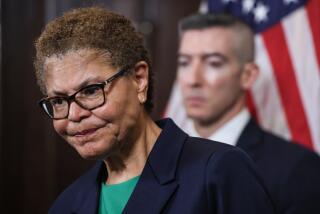Lavish spending not the culprit
- Share via
FROM SACRAMENTO — There’s a giant Christmas tree all lit up outside California’s Capitol. But inside, the place is hardly filled with tidings of joy.
This has not been a season to be jolly.
The state faces a real danger of running out of cash by spring. Major highway projects already are being delayed because the state can’t sell bonds. It’s facing a $15-billion deficit in the fiscal year that ends June 30 and, if nothing’s done about it, another $25-billion-plus for the next fiscal year.
That totals $40 billion in red ink. But the figure really is moot because before things ever get that bad, state government will have collapsed.
Everybody’s pointing fingers as they squabble over a solution.
The Republican governor and Democratic legislators ridicule GOP lawmakers as ultraconservative, inflexible obstructionists because they refuse to vote for a tax increase.
Democrats are denounced by Republicans as out-of-control spenders. Nothing new there. But now the GOP also is taking dead aim at Gov. Arnold Schwarzenegger. And why not? Virtually nothing gets spent without a governor’s sign-off.
But how lavish has been the spending on Schwarzenegger’s watch?
Assembly Republican Leader Mike Villines of Clovis last week pegged the spending growth at 43% and asserted: “It is unfortunate that the governor and Democrats are only interested in raising taxes.”
That’s not quite true. Democrats last week passed a bill that would have pared spending by $7.3 billion -- on top of $11 billion in previous program cuts this year -- while raising taxes and fees by $9.3 billion. Schwarzenegger said he’d veto the bill because the cuts weren’t deep enough and the taxes were too high.
Villines’ broadside at Schwarzenegger prompted an angry response from the governor’s office. Communications director Matt David accused Republicans of blocking tax hikes “because they have signed pledges to protect special interests.” And he called the 43% spending growth figure a “factual inaccuracy.” David placed it at only 32%.
Both men were referring to the general fund, the state’s main account, over which the governor exercises the most control. There also are special funds fed by user fees and taxes designated by voters for specific programs.
Added together, the general fund, special funds and bond spending amount to a current grand budget total of $144.5 billion. That’s about a 39% increase over what Schwarzenegger inherited, David calculates.
Like a fool, I set out to find the correct percentage for general fund spending growth. Was it 43% or 32%?
The answer depends on what you count, of course. And remember that Schwarzenegger took office in November 2003.
Villines’ 43% figure uses as its base the last budget signed by recalled Gov. Gray Davis in late summer 2003. That number is compared with the current budget signed by Schwarzenegger in September. The adopted general fund budgets for each year are $71.1 billion and $103.4 billion, respectively. And that actually amounts to 45% growth.
David’s 32% growth figure uses a higher base: the final 2003-04 spending total of $78.3 billion that was calculated after all the bills had been paid, long past the end of the fiscal year. That figure will go into the archives as the year’s official general fund spending total.
But the GOP has a good point: When the administration compares final spending for 2003-04 with merely an adopted budget for 2008-09, it’s like comparing fruitcake to eggnog.
There’s less contention over what accounts for the spending growth. For that, I checked with the state Finance Department.
To begin with, inflation and population combined have grown nearly 25% since Schwarzenegger took office. So that’s responsible for much of the increased spending.
“None of us decided, ‘Oh, boy, let’s have a party and grow government,’ ” said Finance Director Mike Genest. “In all those years, there was virtually no money for new spending commitments.”
Well, there was one commitment. And it amounts to the single biggest chunk of the spending growth, nearly 25% worth. That was paying for Schwarzenegger’s car-tax cut, his first -- and most fiscally imprudent -- act in office.
All the revenue from the car tax -- officially the vehicle license fee -- had gone to local governments. Schwarzenegger cut the tax by two-thirds and generously agreed to “backfill” local governments for their loss with money from the general fund. That’s a $6.2-billion annual hit.
Prisons have swallowed 17% of the spending growth. It’s all those tougher sentences.
Some so-called social programs also have been cost-drivers. Medi-Cal accounts for 17% of the spending increase. As the economy tanks, more people qualify.
Mental healthcare costs are escalating. More kids are being treated and so are a new category of “sexually violent predators.” The cost of developmental services is rising as more children are diagnosed with autism and the population ages. In-home supportive services are costing more because pay is rising for providers. They got tired of bathing and dressing invalid shut-ins on minimum wages.
Education? K-12 schools account for only 12% of the spending growth.
One other item: We’re up to $6.1 billion in annual debt payments on loans.
It all adds up to relatively modest, real spending growth, less than under most modern governors.
The biggest sin of Schwarzenegger and Legislature has been muddling along, unwilling to confront the inevitable need for both spending cuts and tax increases.
And the greatest transgression was that car-tax cut. Largely because of it, Sacramento again will be kicking the aged, blind and disabled. Bah, humbug.
--
More to Read
Get the L.A. Times Politics newsletter
Deeply reported insights into legislation, politics and policy from Sacramento, Washington and beyond. In your inbox twice per week.
You may occasionally receive promotional content from the Los Angeles Times.











